| dc.contributor.author | Hallal, Pedro C. | |
| dc.contributor.author | Andersen, Lars Bo | |
| dc.contributor.author | Bull, Fiona C. | |
| dc.contributor.author | Guthold, Regina | |
| dc.contributor.author | Haskell, William | |
| dc.contributor.author | Ekelund, Ulf | |
| dc.date.accessioned | 2012-10-11T07:56:07Z | |
| dc.date.available | 2012-10-11T07:56:07Z | |
| dc.date.issued | 2012-07-18 | |
| dc.identifier | Seksjon for idrettsmedisinske fag / Department of sports medicine | |
| dc.identifier.citation | The Lancet. 2012, 380(9838), 247-257 | no_NO |
| dc.identifier.issn | 0140-6736 | |
| dc.identifier.uri | http://hdl.handle.net/11250/170988 | |
| dc.description | I Brage finner du siste tekst-versjon av artikkelen, og den kan inneholde ubetydelige forskjeller fra forlagets pdf-versjon. Forlagets pdf-versjon finner du på www.thelancet.com: http://dx.doi.org/10.1016/S0140-6736(12)60646-1 / In Brage you'll find the final text version of the article, and it may contain insignificant differences from the journal's pdf version. The original publication is available at www.thelancet.com: http://dx.doi.org/10.1016/S0140-6736(12)60646-1 | no_NO |
| dc.description.abstract | To implement effective non-communicable disease prevention programmes, policy makers need data for physical activity levels and trends. In this report, we describe physical activity levels worldwide with data for adults (15 years or older) from 122 countries and for adolescents (13—15-years-old) from 105 countries. Worldwide, 31·1% (95% CI 30·9—31·2) of adults are physically inactive, with proportions ranging from 17·0% (16·8—17·2) in southeast Asia to about 43% in the Americas and the eastern Mediterranean. Inactivity rises with age, is higher in women than in men, and is increased in high-income countries. The proportion of 13—15-year-olds doing fewer than 60 min of physical activity of moderate to vigorous intensity per day is 80·3% (80·1—80·5); boys are more active than are girls. Continued improvement in monitoring of physical activity would help to guide development of policies and programmes to increase activity levels and to reduce the burden of non-communicable diseases. | no_NO |
| dc.language.iso | eng | no_NO |
| dc.publisher | Elsevier | no_NO |
| dc.subject | adolescent | no_NO |
| dc.subject | adult | no_NO |
| dc.subject | developed countries | no_NO |
| dc.subject | developing countries | no_NO |
| dc.subject | exercise | no_NO |
| dc.subject | health behavior | no_NO |
| dc.subject | middle aged | no_NO |
| dc.subject | motor activity | no_NO |
| dc.subject | population surveillance | no_NO |
| dc.subject | risk factors | no_NO |
| dc.subject | self report | no_NO |
| dc.subject | socioeconomic factors | no_NO |
| dc.subject | world health/statistics & numerical data | no_NO |
| dc.subject | young adult | no_NO |
| dc.title | Global physical activity levels: surveillance progress, pitfalls, and prospects | no_NO |
| dc.type | Journal article | no_NO |
| dc.type | Peer reviewed | no_NO |
| dc.subject.nsi | VDP::Medical disciplines: 700::Basic medical, dental and veterinary science disciplines: 710 | no_NO |
| dc.subject.nsi | VDP::Medical disciplines: 700::Clinical medical disciplines: 750 | no_NO |
| dc.subject.nsi | VDP::Medical disciplines: 700::Health sciences: 800 | no_NO |
| dc.source.pagenumber | 247-257 | no_NO |
| dc.source.volume | 380 | no_NO |
| dc.source.journal | The Lancet | no_NO |
| dc.source.issue | 9838 | no_NO |
